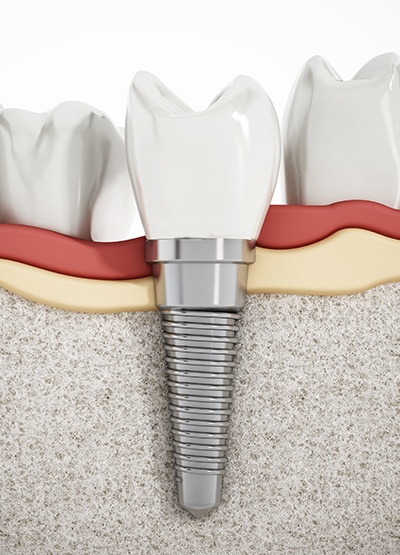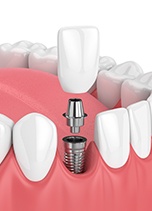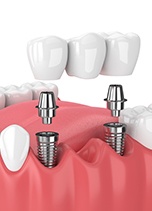Dentistry
7:00 am - 5:00 pm
7:00 am - 5:00 pm
7:00 am - 5:00 pm
7:00 am - 4:00 pm
8:00 am - 12:00 pm
Dental Implants – Weatherford, TX
Securing a Reliable
New Smile
A dental implant is not like other forms of tooth replacement. It doesn’t just fill in the empty space that most people would see; it also fills the void left by the roots of the original teeth. Implants can serve as a sturdy foundation for all kinds of restorations, and they actively contribute to a healthier mouth by stimulating the jawbone. Are you interested in using implants to restore your smile? Call Wright Family Dentistry today to learn more about the process.
Why Choose Wright Family Dentistry for Dental Implants?
-
Implant Posts Placed
In-House - State-of-the-Art Technology
- Known for Great Customer Service
What are Dental Implants?

A dental implant is shaped like a screw and is normally made of titanium. It doesn’t look like a tooth on its own, but that’s because it’s meant to support a crown or another type of restoration. What makes implants unique is that they directly join with the jawbone, serving as a replacement structure for the roots of the natural teeth. This allows your new implant-supported tooth or teeth to look, feel, and function extremely similarly to your natural ones.
The 4-Step Dental Implant Process

- Step 1: You can schedule a dental implant consultation at our office. After we examine your mouth, we can figure out how many dental implants you’ll need and what kind of preparations we’ll need to make to ensure that your mouth can safely support the posts.
- Step 2: We will perform the surgery to place your implants in-house, which saves you the trouble of having to see a specialist at a separate office.
- Step 3: The implant will bond with the jawbone over the course of 3 to 6 months, and afterwards we can attach a connector piece called an abutment to the post.
- Step 4: Impressions will be taken to design your final restoration. We’ll call you back to our office one last time to attach the crown, bridge, or denture to the posts.
Benefits of Dental Implants

Dental implants are considered the modern gold standard of tooth replacement, as they offer the following benefits:
- They can actively prevent tooth loss by stimulating the jaw, which is a function normally performed by the natural tooth roots.
- They are very comfortable, and patients often say they feel just like their natural teeth.
- Implants keep your new restorations from slipping or moving out of place; you can consider them an upgrade for regular dentures.
- Implants don’t require much maintenance, and they can easily last for decades.
Who Dental Implants Can Help

Do you have at least one missing tooth? Is your mouth healthy? Are you in good health overall? Is your jawbone strong enough to support implant posts? If the answer to all of those questions is yes, you are likely a candidate for dental implants. If not, we can discuss bone grafts and other kinds of treatment that might make the treatment viable. The number of implant posts you get and the kind of restoration they support will vary depending on how severe your tooth loss was.
Missing Single Tooth

Obviously, only one dental implant post is needed for a single lost tooth. The post will be placed very carefully in the jaw, and it will be restored with a crown after the area around it has fully healed. A dental implant is a good alternative to a bridge that would require permanent alterations to your natural teeth.
Missing Multiple Teeth

There are several solutions to replacing multiple teeth with implants. You can get a dental bridge that’s supported by a pair of implants in order to replace consecutive teeth, and you can fill in multiple gaps in different locations with an implant-retained partial denture. We’ll go over your options with you during your initial consultation.
Understanding the Cost of Dental Implants

The cost of dental implants is not something that is set in stone. Patients who only need to replace one tooth with a single dental implant will not have to pay the same costs as patients who need to replace multiple teeth throughout the mouth. Once we’ve figured out the steps we’ll need to take to fully restore your smile with implants, we can discuss the relevant costs with you and help you figure out ways to make your new teeth more affordable.
A History of Dental Implants

Dental implants as we know them today were first placed in 1965 by an orthopedic surgeon named Branemark. He had accidentally discovered osseointegration in 1952 in an experiment that involved placing titanium in rabbits. Over time, he figured out that this process could be used to place titanium posts in the jaw to act as tooth roots. Since that time, further advancements have made dental implant placement an even more reliable procedure; today the success rate is around 95%.